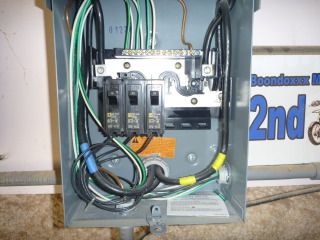I wanted to make sure I was seeing this subpanel correctly. The neutral and grounding conductors are not to be on the same bus bar with the equipment ground (as shown)?
What is the location of the panel?
A garage outbuilding separate from the house
Then it’s probably OK unless it was a very recent installaion. Prior to the 2008 separate structures were permitted to use the grounded conductor for system grounding with a few restrictions.
Was a bond screw present in the panel?
Yes a better photo would help. :mrgreen:
I don’t think those panels come with a bonding means.
So then it’s not suitable for use a service equipment which brings up other issues with the disconnecting means.
Is the neutral bonded to the enclosure?
A sub-panel requires 4 cables from the main disconnect.
2 hots, 1 neutral and 1 ground.
The neutral and ground cannot be bonded together in a sub-panel. Sub-panels require a free floating neutral back to the main disconnect.
NEC 250.142b
Prior to the 2008 NEC a subpanel in a separate building was allowed to have the neutral and EGC’s connected together.
not sure about Texas…
But all electrical additions / expansions
in this area require Inspection by Electrical Underwriter (in addition to Municipal Permit)
If Municipal Permits are not available to view…
and Underwriter Seal
is not present on the Panel referencing additions…
The installation is deficient…
TREC won’t care that it used to be OK. Write it as a defect.
A thread that should be read about the same subject:
Does that look like a bond screw to the right of the GEC? The head is different and looks slightly greenish.
More good discussions:
Thanks for the replies. I had already written it up as deficient (TX), but I’m was fuzzy on the actual requirements for sub panel installation like this.
Chuck, while researching online I actually came across a youtube video of you pointing this problem out in a subpanel.
The 1999 NEC 250.142(b) requires neutral separated from ground in a sub-panel. (aka: free-floating neutral) Page 70-99
The 2004 Code Check has a great illustration of the same.
Take a look at 250.32(B) prior to 2008 NEC.


